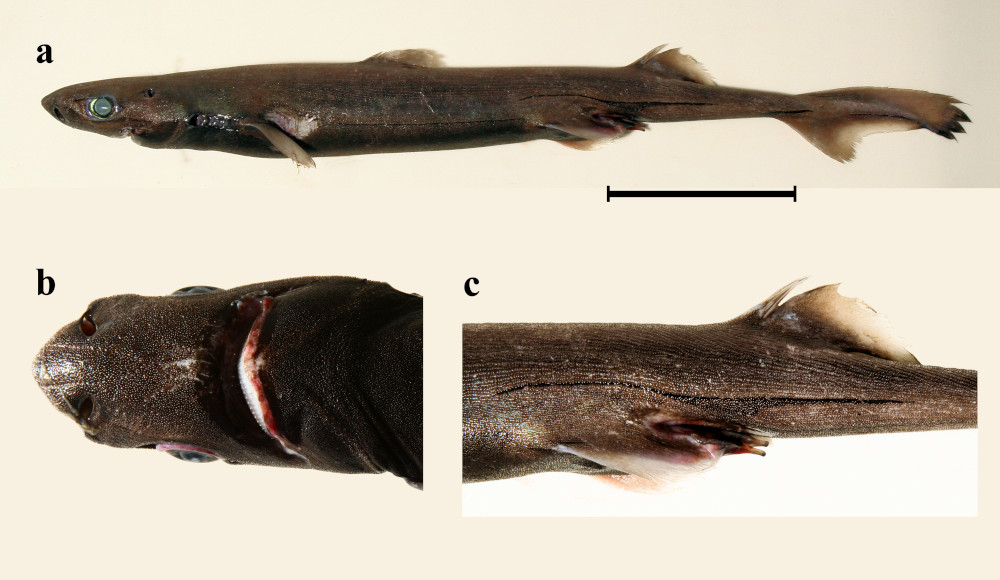Etmopterus brosei
Ebert, Leslie & Weigmann, 2021
Classification: Elasmobranchii Squaliformes Etmopteridae
Reference of the original description
Etmopterus brosei sp. nov.: a new lanternshark (Squaliformes: Etmopteridae) from the southeastern Atlantic and southwestern Indian oceans, with a revised key to the Etmopterus lucifer clade. Marine Biodiversity, 51(3), Article 53
Etmopterus brosei sp. nov.: a new lanternshark (Squaliformes: Etmopteridae) from the southeastern Atlantic and southwestern Indian oceans, with a revised key to the Etmopterus lucifer clade. Marine Biodiversity, 51(3), Article 53
Types
Etmopterus brosei
Holotype: ISAM: F41923; Paratype: ISAM: F041936; ISAM: F34407; ISAM: F037718; SAIAB: 25311; SAIAB: 26254; SAIAB: 26255; SAIAB: 26257; SAIAB: 26259; SAIAB: 26260; SAIAB: 26261; SAIAB: 26262; SAIAB: 26263; SAIAB: 26264; SAIAB: 26265; SAIAB: 26266; ZMH: 26194; ZMH: 26195;
Etmopterus brosei
Holotype: ISAM: F41923; Paratype: ISAM: F041936; ISAM: F34407; ISAM: F037718; SAIAB: 25311; SAIAB: 26254; SAIAB: 26255; SAIAB: 26257; SAIAB: 26259; SAIAB: 26260; SAIAB: 26261; SAIAB: 26262; SAIAB: 26263; SAIAB: 26264; SAIAB: 26265; SAIAB: 26266; ZMH: 26194; ZMH: 26195;
Description :
Citation: Etmopterus brosei Ebert, Leslie & Weigmann, 2021: In: Database of modern sharks, rays and chimaeras, www.shark-references.com, World Wide Web electronic publication, Version 04/2024
Please send your images of "Etmopterus brosei" to info@shark-references.com

Etmopterus brosei Ebert, Leslie & Weigmann, 2021, holotype (SAMC-F41923) before preservation in lateral view (a), ventral view of snout (b), and close up view of lateral flank marking (c). Scale bar: 10 cm © Ebert, Leslie & Weigmann, 2021

Etmopterus brosei Ebert, Leslie & Weigmann, 2021, holotype (SAMC-F41923) before preservation in lateral view (a), ventral view of snout (b), and close up view of lateral flank marking (c). Scale bar: 10 cm © Ebert, Leslie & Weigmann, 2021
Common names
 Barrie’s Lanternshark
Barrie’s Lanternshark
 Barrie’s Lanternshark
Barrie’s Lanternshark
Short Description
Original diagnosis of EBERT, LESLIE & WEIGMANN, 2021 [29730]: A relatively large linear-denticled lanternshark was assigned to the E. lucifer clade and distinguished from all other clade members, except for three species, by an anterior flank marking branch longer than its posterior branch. The new species is distinguished from its closest congener E. sculptus by an indistinct color gradation between the flank and abdomen vs a sharp demarcation between the flank and abdomen, a V-shape arrangement of ampullae on the ventral snout surface with evenly distributed dermal denticles vs a Ushape arrangement with sparse denticle coverage, dorsal fins densely covered with dermal denticles vs sparse or mostly bare dorsal fins, and higher vertebral (85–88 vs 78–85) and spiral valve turn (11 vs 8–9) counts. The new species can be separated from the other two closest E. lucifer clade species, E. lailae and E. lucifer, by a longer posterior flank marking branch extending to or beyond the end of the second dorsal fin free rear tip vs shorter branch not reaching the rear tip, an upper caudal lobe with a dark terminal band or spot, which is absent in these other two species, and biogeography with the new species occurring in the southern African region vs the central and western Pacific Ocean.
Original diagnosis of EBERT, LESLIE & WEIGMANN, 2021 [29730]: A relatively large linear-denticled lanternshark was assigned to the E. lucifer clade and distinguished from all other clade members, except for three species, by an anterior flank marking branch longer than its posterior branch. The new species is distinguished from its closest congener E. sculptus by an indistinct color gradation between the flank and abdomen vs a sharp demarcation between the flank and abdomen, a V-shape arrangement of ampullae on the ventral snout surface with evenly distributed dermal denticles vs a Ushape arrangement with sparse denticle coverage, dorsal fins densely covered with dermal denticles vs sparse or mostly bare dorsal fins, and higher vertebral (85–88 vs 78–85) and spiral valve turn (11 vs 8–9) counts. The new species can be separated from the other two closest E. lucifer clade species, E. lailae and E. lucifer, by a longer posterior flank marking branch extending to or beyond the end of the second dorsal fin free rear tip vs shorter branch not reaching the rear tip, an upper caudal lobe with a dark terminal band or spot, which is absent in these other two species, and biogeography with the new species occurring in the southern African region vs the central and western Pacific Ocean.
Distribution
from the west coast of South Africa to the western Agulhas Bank, off southern Mozambique and on the southern end of the Madagascar Ridge, southwestern Indian Ocean and at Walters Shoal [29730]
from the west coast of South Africa to the western Agulhas Bank, off southern Mozambique and on the southern end of the Madagascar Ridge, southwestern Indian Ocean and at Walters Shoal [29730]
Dentition
Teeth dissimilar in upper and lower jaw; upper teeth multicuspid in two or three functional series, functional teeth in lower jaw unicuspid in single series, with about five series of replacement teeth in upper and lower jaw; multicuspid upper teeth small, perpendicular, with strong central cusp flanked by three lateral cusplets on each side, decreasing size distally; teeth in lower jaw fused into single row, blade-like, cusp oblique, semi-erect. [29730]
Teeth dissimilar in upper and lower jaw; upper teeth multicuspid in two or three functional series, functional teeth in lower jaw unicuspid in single series, with about five series of replacement teeth in upper and lower jaw; multicuspid upper teeth small, perpendicular, with strong central cusp flanked by three lateral cusplets on each side, decreasing size distally; teeth in lower jaw fused into single row, blade-like, cusp oblique, semi-erect. [29730]
Remarks
shark-references Species-ID=16134;
shark-references Species-ID=16134;


















